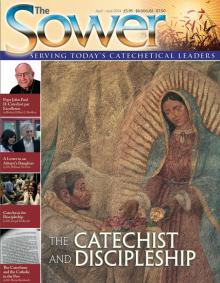Andrea Mantegna painted ‘The Agony in the Garden’ on a wood panel using egg tempera (around 1458-1460), and it measures 25” by 32” (63 x80 cms). It is, therefore, too large to be part of a predella and too small to be an altarpiece, so it is most likely that it was painted for private devotion. Mantegna’s brother-in-law, Giovanni Bellini, painted an ‘Agony in the Garden’ in 1465, and the two paintings hang on the same wall of Room 62 in the National Gallery in London.
All his life Mantegna was interested in rocks and ruins and then studied them intensively. This fascination is manifested in the structure of the painting. Christ is shown centrally, kneeling in prayer on a rock formation which clearly represents and altar. This tells us that the episode in the Garden of Gethsemane is part of the Passover sacrifice which begins in the Upper Room and continues towards Calvary on the morrow.
The rest of this online article is available for current Guild members.
This article is from The Sower and may be copied for catechetical purposes only. It may not be reprinted in another published work without the permission of Maryvale Institute. Contact [email protected]

















